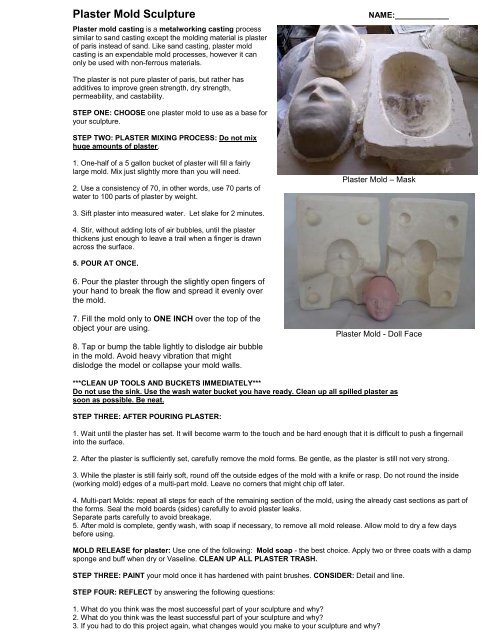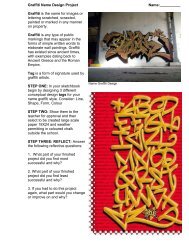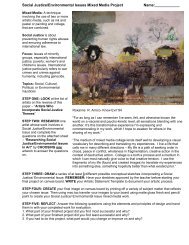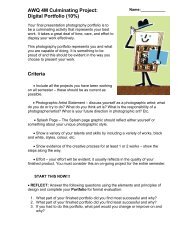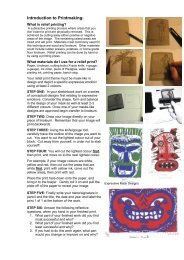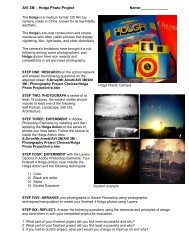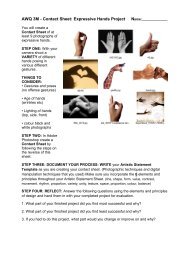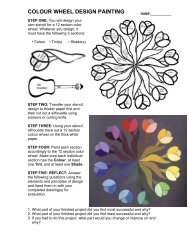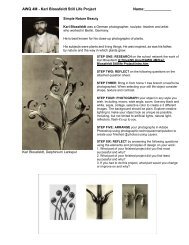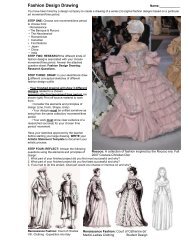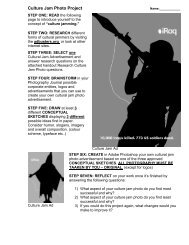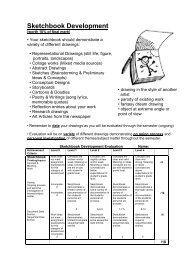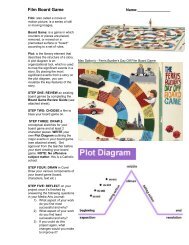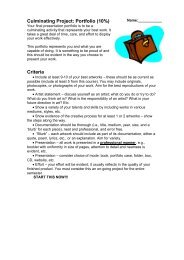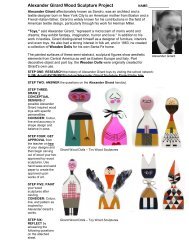Plaster Mold Sculpture (.PDF)
Plaster Mold Sculpture (.PDF)
Plaster Mold Sculpture (.PDF)
Create successful ePaper yourself
Turn your PDF publications into a flip-book with our unique Google optimized e-Paper software.
<strong>Plaster</strong> <strong>Mold</strong> <strong>Sculpture</strong><br />
<strong>Plaster</strong> mold casting is a metalworking casting process<br />
similar to sand casting except the molding material is plaster<br />
of paris instead of sand. Like sand casting, plaster mold<br />
casting is an expendable mold processes, however it can<br />
only be used with non-ferrous materials.<br />
NAME:____________<br />
The plaster is not pure plaster of paris, but rather has<br />
additives to improve green strength, dry strength,<br />
permeability, and castability.<br />
STEP ONE: CHOOSE one plaster mold to use as a base for<br />
your sculpture.<br />
STEP TWO: PLASTER MIXING PROCESS: Do not mix<br />
huge amounts of plaster.<br />
1. One-half of a 5 gallon bucket of plaster will fill a fairly<br />
large mold. Mix just slightly more than you will need.<br />
2. Use a consistency of 70, in other words, use 70 parts of<br />
water to 100 parts of plaster by weight.<br />
<strong>Plaster</strong> <strong>Mold</strong> – Mask<br />
3. Sift plaster into measured water. Let slake for 2 minutes.<br />
4. Stir, without adding lots of air bubbles, until the plaster<br />
thickens just enough to leave a trail when a finger is drawn<br />
across the surface.<br />
5. POUR AT ONCE.<br />
6. Pour the plaster through the slightly open fingers of<br />
your hand to break the flow and spread it evenly over<br />
the mold.<br />
7. Fill the mold only to ONE INCH over the top of the<br />
object your are using.<br />
8. Tap or bump the table lightly to dislodge air bubble<br />
in the mold. Avoid heavy vibration that might<br />
dislodge the model or collapse your mold walls.<br />
<strong>Plaster</strong> <strong>Mold</strong> - Doll Face<br />
***CLEAN UP TOOLS AND BUCKETS IMMEDIATELY***<br />
Do not use the sink. Use the wash water bucket you have ready. Clean up all spilled plaster as<br />
soon as possible. Be neat.<br />
STEP THREE: AFTER POURING PLASTER:<br />
1. Wait until the plaster has set. It will become warm to the touch and be hard enough that it is difficult to push a fingernail<br />
into the surface.<br />
2. After the plaster is sufficiently set, carefully remove the mold forms. Be gentle, as the plaster is still not very strong.<br />
3. While the plaster is still fairly soft, round off the outside edges of the mold with a knife or rasp. Do not round the inside<br />
(working mold) edges of a multi-part mold. Leave no corners that might chip off later.<br />
4. Multi-part <strong>Mold</strong>s: repeat all steps for each of the remaining section of the mold, using the already cast sections as part of<br />
the forms. Seal the mold boards (sides) carefully to avoid plaster leaks.<br />
Separate parts carefully to avoid breakage.<br />
5. After mold is complete, gently wash, with soap if necessary, to remove all mold release. Allow mold to dry a few days<br />
before using.<br />
MOLD RELEASE for plaster: Use one of the following: <strong>Mold</strong> soap - the best choice. Apply two or three coats with a damp<br />
sponge and buff when dry or Vaseline. CLEAN UP ALL PLASTER TRASH.<br />
STEP THREE: PAINT your mold once it has hardened with paint brushes. CONSIDER: Detail and line.<br />
STEP FOUR: REFLECT by answering the following questions:<br />
1. What do you think was the most successful part of your sculpture and why?<br />
2. What do you think was the least successful part of your sculpture and why?<br />
3. If you had to do this project again, what changes would you make to your sculpture and why?
Artistic Statement Template<br />
Artwork Title:______________________________________________<br />
Name:____________<br />
A) <strong>Sculpture</strong> & Painting techniques used in my work and how they support my intended visual message<br />
B) REFLECT by answering the following questions:<br />
1. What do you think was the most successful part of your sculpture and why?<br />
2. What do you think was the least successful part of your sculpture and why?<br />
3. If you had to do this project again, what changes would you make to your sculpture and why?
<strong>Plaster</strong> <strong>Mold</strong> <strong>Sculpture</strong> Evaluation<br />
Name:_____________<br />
Knowledge/<br />
Understanding<br />
Demonstrates<br />
understanding of the<br />
elements & principles<br />
of design in the<br />
sculpture (e.g. form,<br />
balance, colour)<br />
Level 0 Level 1 Level 2 Level 3 Level 4<br />
Work does not<br />
meet<br />
assignments<br />
expectations for<br />
this category.<br />
Incomplete.<br />
0<br />
Student<br />
demonstrates<br />
limited<br />
understanding of<br />
the elements &<br />
principles of design<br />
in the sculpture.<br />
0.25<br />
Student demonstrates<br />
some understanding<br />
of the elements &<br />
principles of design in<br />
the sculpture.<br />
0.50<br />
Student demonstrates<br />
considerable<br />
understanding of the<br />
elements & principles<br />
of design in the<br />
sculpture.<br />
0.75<br />
Student<br />
demonstrates<br />
a high degree of<br />
understanding of<br />
the elements &<br />
principles of design<br />
in the sculpture.<br />
1<br />
/1<br />
Thinking/<br />
Inquiry<br />
Concept:<br />
<strong>Plaster</strong> <strong>Mold</strong><br />
Work does not<br />
meet<br />
assignments<br />
expectations for<br />
this category.<br />
Incomplete.<br />
0<br />
Concept and<br />
context is unclear<br />
and/or weak.<br />
Meaning or ideas<br />
conveyed are not<br />
on par with student<br />
grade level.<br />
0.25<br />
Concept and context<br />
is slightly unclear<br />
and/or weak.<br />
Meaning or ideas<br />
conveyed are below<br />
expectations for<br />
student’s grade level.<br />
0.50<br />
Concept and context<br />
is clear and valid.<br />
Meaning or ideas<br />
conveyed are on par<br />
with student’s grade<br />
level.<br />
0.75<br />
Concept and<br />
context is clear<br />
and strong.<br />
Meaning or ideas<br />
conveyed are<br />
above<br />
expectations for<br />
grade level. 1<br />
/1<br />
Communication<br />
Explains use of<br />
painting & sculpture<br />
techniques in the<br />
<strong>Plaster</strong> <strong>Mold</strong><br />
handout<br />
Reflective Questions<br />
Incomplete.<br />
0<br />
Incomplete.<br />
0<br />
Student explains<br />
use of painting &<br />
sculpture<br />
techniques in the<br />
<strong>Plaster</strong> <strong>Mold</strong><br />
handout with<br />
limited clarity.<br />
0.25<br />
Poor, yes/no<br />
answers/limited<br />
incomplete.<br />
0.25<br />
Student explains use<br />
of painting &<br />
sculpture techniques<br />
in the <strong>Plaster</strong> <strong>Mold</strong><br />
handout with some<br />
clarity.<br />
0.50<br />
Somewhat coherent<br />
and somewhat<br />
complete. 0.50<br />
Student explains use<br />
of painting &<br />
sculpture techniques<br />
in the <strong>Plaster</strong> <strong>Mold</strong><br />
handout with<br />
considerable clarity.<br />
0.75<br />
Clear and substantial<br />
answers.<br />
0.75<br />
Student explains<br />
use of painting &<br />
sculpture<br />
techniques in the<br />
<strong>Plaster</strong> <strong>Mold</strong><br />
handout with a<br />
high degree of<br />
clarity.<br />
1<br />
Superior and<br />
insightful answers.<br />
1<br />
/1<br />
/1<br />
Application<br />
Creative Process:<br />
Demonstration of<br />
Skill Development &<br />
following procedures<br />
including Clean Up<br />
Uses elements &<br />
principles of design<br />
& painting sculpture<br />
techniques to<br />
produce an effective<br />
artwork – Painted<br />
<strong>Plaster</strong> <strong>Mold</strong><br />
Detail<br />
Incomplete.<br />
0<br />
Incomplete.<br />
0<br />
Incomplete.<br />
0<br />
Student<br />
demonstrates<br />
limited<br />
effectiveness in<br />
demonstrating the<br />
creative process<br />
and following<br />
procedures.<br />
5<br />
Student<br />
demonstrates<br />
limited use of the e<br />
& ps of design and<br />
sculpture<br />
techniques to<br />
produce an art<br />
work of limited<br />
effectiveness.<br />
1<br />
The work is<br />
painted with<br />
little/no detail.<br />
1<br />
Student demonstrates<br />
some effectiveness in<br />
demonstrating the<br />
creative process and<br />
following procedures.<br />
5-6<br />
Student demonstrates<br />
some use of the e &<br />
ps of design and<br />
sculpture techniques<br />
to produce an art<br />
work of some<br />
effectiveness.<br />
2-3<br />
The work is painted<br />
with some detail.<br />
2<br />
Student demonstrates<br />
considerable<br />
effectiveness in<br />
demonstrating the<br />
creative process and<br />
following procedures.<br />
7-8<br />
Student demonstrates<br />
considerable use of<br />
the e & ps of<br />
sculpture and painting<br />
techniques to produce<br />
an art work of<br />
considerable<br />
effectiveness.<br />
3-4<br />
The work is painted<br />
with adequate detail.<br />
3-4<br />
Student<br />
demonstrates<br />
superior<br />
effectiveness in<br />
demonstrating the<br />
creative process<br />
and following<br />
procedures.<br />
8- 10<br />
Student<br />
demonstrates a<br />
high degree of<br />
using the e & ps of<br />
design and<br />
sculpture<br />
techniques to<br />
produce a highly<br />
effective art work.<br />
5<br />
The work is<br />
painted with<br />
substantial detail.<br />
5<br />
A1. The Creative Process: apply the creative process to create a variety of art works, individually and/or collaboratively;<br />
A1.1 use a variety of strategies, individually and/or collaboratively, to generate Ideas and to develop plans for the creation of art works<br />
(e.g., in small groups, use brainstorming, research, concept webs, and/or mind maps to generate original and imaginative ideas; filter their<br />
ideas to select a suitable one to serve as the basis for their art work; use notes and/or thumbnail sketches to help them develop clear and<br />
flexible plans that show attention to detail; revise their plans on the basis of peer- and self-assessment)<br />
A1.2 use experimentation, reflection, and revision when producing a variety of art works in each of the following areas: drawing, sculpture,<br />
painting, printmaking, and mixed media (e.g., experiment with a variety of materials/media, techniques, and tools to find ones that are<br />
appropriate for their planned art work; reflect on their preliminary work and on feedback from their peers before revising their art work)<br />
A1.3 document their use of the creative process in a portfolio (e.g., include evidence of their conceptual, creative, and technical skills;<br />
include thumbnail<br />
sketches, checklists, and/or graphic organizers to show evidence of experimentation, reflection, and revision), and refer to this portfolio to<br />
reflect on how effectively they have used the creative process<br />
A2. The Elements and Principles of Design: apply elements and principles of design to create artworks for the purpose of self-expression and to<br />
communicate ideas, information, and/or messages;<br />
A2.1 use various elements and principles of design to create art works that express personal feelings and/or communicate emotions to an<br />
audience (e.g., create a mixed-media self-portrait that uses colour, line, and shape in the style of Frida Kahlo to convey their personality<br />
and elicit emotions from the audience)<br />
A2.2 apply elements and principles of design as well as art-making conventions to create art works that communicate ideas, information,<br />
or messages, and/or that convey a point of view on an issue (e.g., use colour, line, shape, contrast, and emphasis when creating a graffiti<br />
piece that addresses an issue in their local community; incorporate symbolism to communicate a message about an environmental issue)<br />
A3. Production and Presentation: produce art works, using a variety of media/materials and traditional and/or emerging technologies, tools, and<br />
techniques, and demonstrate an understanding of a variety of ways of presenting their works and the works of others.<br />
/10<br />
/5<br />
/5<br />
/24
3.1 explore and experiment with a variety of materials/media, including alternative media, and traditional and/or emerging technologies,<br />
tools, and techniques, and apply them to create art works<br />
B1. The Critical Analysis Process: demonstrate an understanding of the critical analysis process by examining, interpreting, evaluating, and reflecting<br />
on various art works;<br />
B1.1 identify and describe their initial reactions to a variety of art works, and explain the reasons for their reactions (e.g., the aspects of the<br />
work and/or their personal experiences that contributed to their first impressions of its mood, subject, intent)<br />
B1.2 identify and describe the elements and principles of design used in their own art works and the works of others, and describe their<br />
effects (e.g., how line, colour, and shape are used to create emphasis, mood, and/or movement)<br />
B1.3 explore and interpret a variety of art works, both historical and contemporary, to identify and describe their purpose and style, the<br />
materials used, and the meanings the works convey<br />
B1.4 use a variety of strategies (e.g., peer- and self-assessment, formal critiques, feedback and reflection following public displays) to<br />
identify and reflect on the qualities of their own art works and the works of others, and evaluate the effectiveness of these works<br />
B2. Art, Society, and Values: demonstrate an understanding of how art works reflect the societies in which they were created, and how they can<br />
affect personal values;<br />
B2.1 identify and describe the function of various types of art works in past and present societies<br />
B2.2 identify and describe ways in which various art works reflect the societies in which they were created<br />
C1. Terminology: demonstrate an understanding of, and use correct terminology when referring to, elements, principles, and other components<br />
related to visual arts;<br />
C1.1 use appropriate terminology related to elements and principles of design when creating and analysing art works<br />
C1.2 use appropriate vocabulary to describe techniques, materials, and tools when creating and presenting visual art works<br />
C1.3 identify and describe the stages of the creative process and the critical analysis process (e.g., how reflection relates to the other<br />
stages of the creative process)<br />
C2. Conventions and Techniques: demonstrate an understanding of conventions and techniques used in the creation of visual art works;<br />
C2.2 demonstrate an understanding of several conventions used in visual art works (e.g., exaggeration, metaphor, simile, symbols,<br />
synectics; conventions associated with heroic, narrative, naturalistic, and satirical works)<br />
C3. Responsible Practices: demonstrate an understanding of responsible practices in visual arts.<br />
C3.2 demonstrate an understanding of safe and conscientious practices associated with the use of materials, tools, and technologies in<br />
visual arts, and apply these practices when creating and/or presenting art works (e.g., use appropriate precautions when dealing with<br />
hazardous materials; adopt protective measures when using sharp tools; keep their work space clean and free of physical and other<br />
hazards; demonstrate respect for classroom facilities, tools, equipment, and technological devices)


